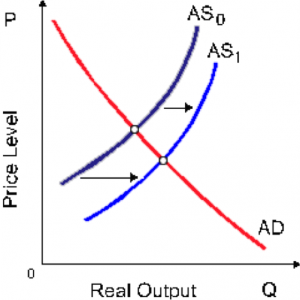Currently wage growth is at is all time low since 1982. The decrease in costs will result in more disposable money that can be used in several different ways such as investment in infrastructure, human capital or technology. If the business decides to invest in human capital this will cause for the SRAS to increase. an example of an investment on human capital can be training programs which will make the labour more skilled, thereby improving the quality of human capital. The skills gained from the training will convert to an increase in productivity. More productive labour will lead to higher output which can be translated into increasing SRAS in economic terms.
Picture: http://www.bized.co.uk/educators/16-19/economics/adas/activity/adas.htm
The effects of a shift rightwards in the SRAS curve will cause will cause a increase in output. Because with the training program the employee’s have become more skilled. Higher levels of skill will result in more productivity and output. this shift will increase revenue’s of the firm and will also benefit the RGDP in a macroeconomic perspective. From my knowledge of COMM101 we have learned that employee turnover is a big issue in firms and constant hiring is very costly. Firms, through investing in their employee’s can increase revenue’s and decrease turnover resulting in a better more successful company.
COMM101 Topic: Macroeconomics, Human Resources and Investment
| Name | B Kirk |
| Student Number | 20557138 |
| Course Section | 102 |
| Article Title | Wage growth may mean inflation ahead |
| Source | http://www.businessweek.com/articles/2013-01-08/wage-growth-may-mean-inflation-ahead#r=glo-lst |
| Date article published | Jan 08, 2013 |
| Date blog post written | Oct 07, 2013 |
| Word count | 211 |
